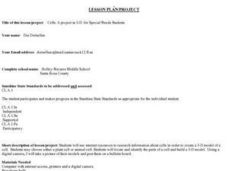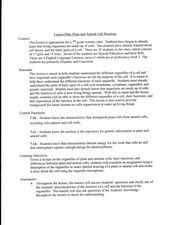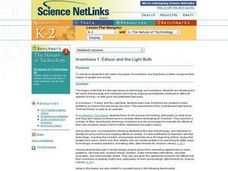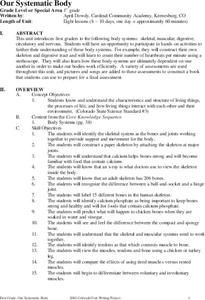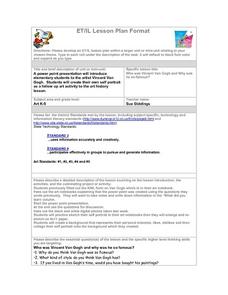Curated OER
THE CELL: DESIGN AND FUNCTION
After studying the structure and functions of living cells using textbooks, internet or encyclopedias, students prepare a PowerPoint presentation on cell structure and present it to the class.
Curated OER
Stem Cell Differentiation Game
This carad activity helps learners explore detailed facts and scientific procedures around the human body and its cells. In this stem cell lesson, students utilize different colored flash cards to represent different types of human...
Curated OER
Nerve Cell Informercials
Students research the structure and function of the nervous system. They prepare a model or representation of neural transmission. Students create an infomercial about nerve cells.
Curated OER
Cells: A project in 3-D for Special Needs Students
Students use the internet to research information about cells in order to create a 3-D model of a cell. They may choose either to research a plant or animal cell. Students locate and identify the parts of a cell and build a 3-D mode.
Curated OER
Genetics and Heredity: The Next Generation
Tenth graders work in teams to order events of DNA transcription and translation protein synthesis. In the second lesson, they put the steps of mitosis and meiosis in order using a concept map poster. They use modeling clay to create...
Curated OER
The Spanish Omelet
Students use analogies to show the relationships among cell, nucleus, genes, chromosome, ribosome, replication, mitosis, transcription, translation, DNA, RNA, amino acids and proteins, genotype, phenotype, and genetics vs. environmental...
Curated OER
Plant and Animal Cell Structure
Seventh graders identify the different parts and functions of the cell. In this biology instructional activity, 7th graders make a labelled diagram of either a plant or animal cell. They write a story about it.
Curated OER
The Sorcerer's Apprentice: 200 Greatest Pop Culture Icons
Upper graders view the animated short, "The Sorcerer's Apprentice" and analyze how the music score was chosen to express the scene. They create an animation as they listen to a classical recording to experience the connection between...
Curated OER
Levels of Organization
High schoolers brainstorm a list of all the functions organisms carry out and how they carry them out. In groups, they are given the smallest and highest level of organization in organisms and are to fill in the missing spaces. To end...
Virginia Department of Education
Genetic Variation and Mutations
Young scientists demonstrate their creativity while completing several activities, to assess genetic variations and mutations. Instructors provide a list of options and scientists choose to write a comic strip, create a book,...
Curated OER
Greenewables
Students form expert engineering teams working for the (fictional) alternative energy consulting firm, Greenewables, Inc. Each team specializes in a form of renewable energy used to generate electrical power: passive solar, solar...
Curated OER
Inventions 1: Edison And The Light Bulb
Students examine the realm and power of inventions, and recognize their impact on people and society. Small groups pretend to have been hired by Edison to make special posters that advertise the uses and benefits of the light bulb.
Curated OER
DNA Blueprint for Life
Learners isolate DNA from different food sources. In this biology lesson, students research DNA extraction. They analyze DNA stands collected from the lab, and compare the differences between each.
Curated OER
Our Systematic Body
Students explore several parts of the body system in the eight lessons of this unit. Through several hands-on activities, the skeletal, muscular, digestive, circulatory and nervous systems are observed.
Curated OER
Building a Clay Neuron
Learners investigate and then build neurons in this lesson. They are examined as key parts of the brain and nervous system and seen as different from normal cells.
Curated OER
Edible DNA
Students use multicolored soft candies (gumdrops and candy orange slices) and toothpicks to create models of DNA structures. They discuss the fact that DNA must copy itself before splitting into two cells. Students demonstrate this by...
Curated OER
Masks from Around the World
Students examine the history of masks, and create their own mask as a culminating activity. They view and discuss a PowerPoint presentation about the history of masks, complete a class KWL chart, create their own mask, and write a...
Curated OER
Website Design Using HTML Code
Students participate in an activity to discover vocabulary necessary for website design. They observe a demonstration of website design using HTML code and then design two simple web pages with specific criteria. The final project allows...
Curated OER
Inventions- The Impact
Learners investigate inventions and the impact they can have on people. In this technology lesson plan, students research Thomas Edison and discuss how the invention of the light bulb impacted others. Learners sketch out an invention...
Curated OER
Vincent Van Gogh
Students examine the life and works of Vincent Van Gogh. They complete a class KWL chart, and watch a PowerPoint presentation about the life of Vincent Van Gogh. Next, they use a digital photo of themselves to create a self-portrait...
Curated OER
Influence of Music On Our Lives: How Does Music Influence our Actions?
Eighth graders research how music influences our actions. They form an educated opinion of how music can influence our actions. Students create a computer generated presentation to outline the research methods used to form their answer....
Curated OER
Octopus Project: Ceramics
Kids make an octopus out of clay. They practice their sculpting and modeling skills such as pinch pot and slurry technique while sculpting an octopus.
Curated OER
How To Make an Artificial Organ
Students examine the advances made in technology with regard to prosthetics and replacement organs and limbs. They describe the anatomy and functions of different organs and create their own artificial organ. They defend and present...




